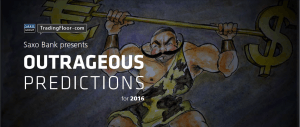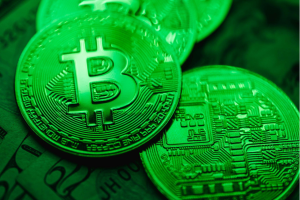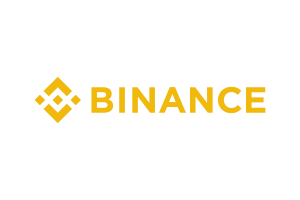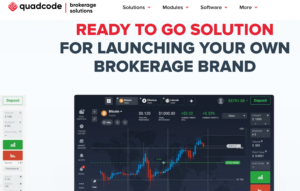Saxo Bank makes ‘Outrageous Predictions’ for 2016! – The full inside view
Here at Saxo Bank’s global headquarters in Hellerup, Denmark, the avantgarde, thought-driven and highly technological ethos of the company is evident on a cellular level. The attention to detail that has gone into creating Saxo Bank’s proprietary trading technology as a valuable intangible is more than reflected in the art-adorned, futuristic office that the company […]

Here at Saxo Bank’s global headquarters in Hellerup, Denmark, the avantgarde, thought-driven and highly technological ethos of the company is evident on a cellular level.
The attention to detail that has gone into creating Saxo Bank’s proprietary trading technology as a valuable intangible is more than reflected in the art-adorned, futuristic office that the company inhabits.
In keeping with the firm’s forward-looking values, Saxo Bank has released its “Outrageous Predictions” for 2016, which have been explained to FinanceFeeds in detail.
The company’s CIO Steen Jakobsen has provided the rationale behind the company’s annual Outrageous Predictions by stating that “The irony in this year’s batch of outrageous predictions is that some of them are “outrageous” merely because they run counter to overwhelming market consensus. In fact, many would not look particularly outrageous at all in more “normal” times – if there even is such a thing!”

“In other words, it has become outrageous to suggest that emerging markets will outperform, that the Russian rouble will be the best-performing currency of 2016, and that the credit market will collapse under the weight of yet more issuance” continues Mr. Jakobsen.
“We have been stuck in a zero-bound, forward-guidance lowering state for so long that there exists a whole generation of traders who have never seen a rate hike from the Federal Reserve. As we close out 2015, it has been nearly 12 years (early 2004) since the US economy was seen as recovering strongly enough to warrant starting a series of hikes – and that series ended in early 2006, nearly ten years ago.”
Steen Jakobsen’s Quarter-century trading career
“I have been trading for over 25 years and I have only seen three Fed rate hike cycles in my entire career: 1994, 1998 and 2004” observed Mr. Jakobsen.
“We are truly entering a new paradigm for many market participants and the new reality is that the marginal cost of money will rise, and thus so will volatility and uncertainty.”
“All of this is embedded in this year’s Outrageous Predictions. As always, it’s rewarding to see how our customers pitch in and how this publication creates a stimulating debate. Our hope is that these predictions might both inspire you and unsettle your more complacent assumptions” he said.
EURUSD direction? It’s 1.23…
Mr. Jakobsen recalls that many years ago back in 1989 he wrote one of his first research reports and made the call that USDDEM should trade all the way down to 1.23. “It was an outrageous call and colleagues from back then still remind me when we meet (the dollar to the deutsche mark was trading in the high 1.60s at the time)” he said.
“Now it’s again time to call for 1.23 but this time in EURUSD. In four of the last five Fed rate hike cycles, the US dollar has peaked around the first hike indicating that the direction of the US dollar is inversely correlated to the Fed rate cycle.” This may appear indeed outrageous, however Mr. Jakobsen’s prediction with regard to this valuation is very much aligned with FinanceFeeds’ perspective.
“A higher EURUSD will not only make the European Central Bank lose face but also catch the consensus out as most investors and traders believe parity between the EUR and USD is only a matter of time. At a macro level the direction of the US dollar will be the single biggest factor in explaining net return for all asset classes” said Mr. Jakobsen.
“The irony here is that if the dollar does not weaken, then the world most likely will be in deep recession as a stronger dollar increases the debt burden for US-dollar funded and dependent emerging markets, lowers profit for bigger US companies, lowers commodity prices through the link of being traded in the dollar and lowers the overall emerging market growth which is more than 50% of world growth today” – Steen Jakobsen, CIO, Saxo Bank
“In other words the path of least resistance for the world to rebalance and get more growth is a weaker dollar if the expected monetary- and fiscal-policy environment plays out as expected from here. Europe is running a massive current account surplus and its weaker inflation should, in macroeconomic logic, mean a stronger currency, not a weaker one. The race to the bottom has gone full circle, meaning we are back to a weaker US dollar again as the main policy response for the US and hence global growth” concurred Mr. Jakobsen.
John J. Hardy, Head of Forex Strategy at Saxo Bank has some further ‘outrageous predictions’ for next year.
“By late 2015, the combination of collapsing oil prices and financial sanctions against Russia over the situation in Ukraine saw a rough ride for Russian assets and its currency, the rouble. But in 2016, oil prices surge again as demand growth in the US and especially China outstrip overly pessimistic estimates, just as US oil production growth is slowing and even reversing on a financial debacle linked to shale oil companies” said Mr. Hardy.

“This is a boon to Russia’s energy dependent economy. Meanwhile, in 2016, the US Federal Reserve allows the US economy to run a little bit hot as the strong USD sees the Fed raising rates at perhaps an inappropriately slow pace. This represents a bonanza for emerging markets and their currencies, in particular Russia as commodity bears are left out in the cold in 2016″ he said.
Meanwhile, Russian assets and its currency get an extra boost as new geopolitical alignment pressures bring Russia and its adversaries to the negotiation table and provide visibility for an exit from the vicious standoff that had left Russian assets under-weighted globally and therefore undervalued over the last year and more.”
“Flows from international investors and Russian repatriation flows flood back into the Russian economy. By the end of 2016, the Russian rouble, including carry from Russia’s high interest rates, rises some 20% versus the US dollar/euro basket in 2016” is Mr. Hardy’s view.
As interest in multi-asset trading increases, what about Equities? Peter Granry, Head of Equity Strategy at Saxo Bank explains
“The first half of 2015 had the lowest number of venture capital deals in 25 years as VC firms rushed to plough money into so-called unicorns – startups valued above $1 billion each. This rush to capture everything that might have blockbuster potential inflated the bubble in unlisted US tech firms” said Mr. Granry.
“2016 will smell a little like 2000 in Silicon Valley with more startups delaying monetisation and tangible business models in exchange for adding users and trying to achieve critical mass. Remember the dotcom gospel of clicks and page views instead of focusing on revenue and profits?”
“Fidelity’s recent writedown of its Snapchat stake by 25% underscores the increasing uncertainty over valuations of VC-backed tech firms. Snapchat, let’s not forget, was valued at around 160x on price-to-sales” – Peter Granry, Head of Equity Strategy, Saxo Bank
“As the USD rate cycle gets priced into all asset classes in 2016, yields on alternative investments to VC-backed startups will go up. This, combined with US equity markets going sideways in 2016, will spark nervousness among VC investors who are pushing for IPOs” said Mr. Granry, certainly echoing FinanceFeeds CEO Andrew Saks-McLeod’s observations with regard to the IPO landscape over recent times.
Mr. Granry concluded “The harsh reality eventually sinks in that public markets just won’t buy the VC-backed tech firms at highly inflated prices. The resulting carnage could stop the growth in VC funding and halt housing gains in San Francisco (the most overvalued real estate market in the US).”
On a macro level…..
Saxo Bank’s Head of Macro Strategy Mads Koefoed predicts that “The poster child for emerging market weakness is Brazil with its recession, collapsing consumer confidence, skyrocketing unemployment and plunging currency. USDBRL has nearly doubled so far this year while confidence is at a decade low and unemployment is at a five-year high.”

“Oh, and lest we forget; yearly GDP growth has been negative for five straight quarters – and this count could turn double-digit before it is over. A poster child, maybe, but Brazil is hardly alone in struggling to come to terms with the end of the commodity super-cycle, which has morphed into a full-scale oil price meltdown, a weakening China-led global manufacturing cycle and a run-up in dollar-denominated debt. Add uncertainty about the Federal Reserve’s first rate hike in more than a decade to the mix and the picture is bleak” said Mr. Koefoed.
“Against this disturbing backdrop we look for the host of the 2016 Olympics to lead EM out of the current malaise with equities outperforming. Leading indicators are stabilising in China and climbing in India, and recent policy easing furthermore helps the outlook for the former.”
“Stabilisation, investment spending on the Olympics, and modest reforms will see sentiment rebound in Brazil, and EM exports will be helped by cheaper local currencies. The Federal Reserve’s coming rate hike cycle is causing all kinds of commotion in EM, but this ignores that during a typical rate hike cycle, EM equities tend to outperform not only other equities, but also government bonds. The MSCI EM index is trading at a forward P/E of just 12.1 compared to 18.8 for developed market equities – an unreasonable discount. The result: EM equities to have a great year, outperforming bonds and other equities” concluded Mr. Koefoed.
The result: EM equities to climb 25% in 2016!
“Opec turmoil triggers brief return to $100/b oil” – Ole Hansen, Head of Commodity Strategy, Saxo Bank
Mr. Hansen brings in his vast experience in commodities to state that the oil market remains under pressure as we enter 2016 with oversupply and the imminent increase in exports from Iran adding some additional downside pressure. During the first quarter, Brent crude reaches and breaches the 2009 recession low as US tight oil producers continue to show resilience.
“The selling is driven by capitulation from investors in exchange-traded products while hedge funds build a new record short position in the futures market” he said.
“Opec’s crude oil basket price drops to the lowest since 2009 and the unease among weaker as well as wealthier members of the cartel over the supply-and-rule strategy continues to grow as the economic pain spreads across the 12-member group. The long awaited sign of an accelerated slowdown in non-Opec production finally begins to flicker. Suitably buoyed, Opec catches the market on the hop with a downward adjustment in output.”

“That move breaks the downward price spiral and price mounts a quick recovery with investors scrambling to re-enter the market to the long side. With demand growth having remained strong throughout, the focus then turns to the prospect of dwindling future supplies from the scrapping of big multi-billion dollar projects that became unviable in a low-price environment. This combined with the re-introduction of a geopolitical risk premium through the Middle East and other oil-price sensitive zones sees oil spike.”
“At its peak, the price once again brings $100/barrel prices onto the horizon, before settling back into a $50-70/b range. This will require more than an Opec cut, but in an uncertain geopolitical environment, the threat of short-term spikes will remain ever present through 2016.”
What about the weather? Nice day for a surge in inflation
Who would have thought that weather conditions could affect geopolitical events such as inflation? Among seasoned traders, weather is more regarded as a trading instrument on which traders could buy fixed options to predict weather fronts as was common in the exchanges of Chicago in the 1980s, however today, Mr. Granry makes a very interesting point that weather conditions such as the El Nino phenomenon can affect national economies.
“According to many climate forecasters, 2015 and 2016 will likely be the hottest two years on record, adding to the growing number of droughts around the world” said Mr. Granry.
“The volatile weather we’ve experienced in recent years has also increased the number of floods and other devastating weather extremes. On top of this, next year’s El Niño will be the strongest on record and will cause moisture deficits in many areas of southeast Asia and droughts in Australia. Global agricultural production will be affected negatively. Lower yields across agricultural commodities will curb supply at a time when demand is still increasing on the back of global economic expansion” he said.
“The outcome will be a 40% surge in the Bloomberg Agriculture Spot Index, adding some much-needed inflationary pressure. The central bankers in the developed world which have been battling with mega deflationary trends caused by negative demographics, lower private consumption and excess labour capacity will welcome this development. The upshot of all of this is that the tide will start to turn for stagnating wages and the low level of new net investments that have blighted developed economies for far too long” – Peter Granry, Head of Equity Strategy, Saxo Bank
“Luxury is the reflection of an unequal society” – Christopher Dembik, Economist, Saxo Bank
Mr. Dembik has some outrageous predictions with regard to the luxury goods market, observing that luxury is an outward projection of inequality in a society. “The conspicuous consumption of luxury goods and services is a way of demonstrating membership of the elite. The elite is ready to pay extra just for the privilege of it and to differentiate themselves from the rest of society. It is what we call the snob effect” said Mr. Dembik.
“The money spent on luxury cars, jewellery and clothing items could have been used for better infrastructure, education or for poverty alleviation. In that sense, luxury is a net economic loss. Since the global financial crisis, poverty has increased in Europe because of the economic downturn and austerity measures. The International Labour Organization estimates that 123 million people are at risk of poverty in the EU, which represents a quarter of the European population. This total has risen from 116 million in 2008” he said.

“Faced with rising inequality and unemployment of over 10%, Europe is considering the introduction of a basic universal income to ensure that all citizens, regardless of whether they work, can afford to meet their basic needs. In Spain, its implementation is supported by the left-wing populist party Podemos. Finland plans a limited geographical experiment in the coming months and Switzerland has scheduled a referendum on the subject for 2016.”
“In France, more than 10% of the population is at risk of poverty or social exclusion. In 2016, France will decide to guarantee a basic income to its entire population and will cap the highest wages in order to combat inequality and achieve more inclusive economic growth. In a more egalitarian society where other values are promoted, demand for luxury goods decrease sharply. Consumer preferences are moving to products of mass consumption and high-tech. As a result of declining European demand and economic slowdown in emerging countries, particularly China, the luxury sector collapses. Sales of the world leader in luxury, LVMH, fall by over 50%” concluded Mr. Dembik.
Photography at Saxo Bank’s Global Headquarters, Hellerup, Denmark. Copyright Andrew Saks-McLeod









